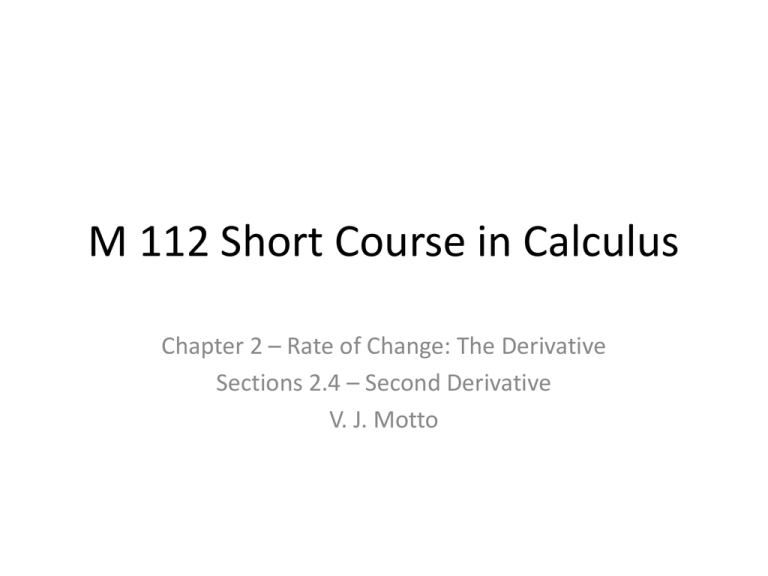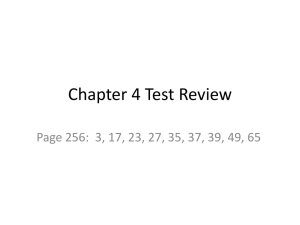
M 112 Short Course in Calculus
Chapter 2 – Rate of Change: The Derivative
Sections 2.4 – Second Derivative
V. J. Motto
Here is the graph of f(x) = x2 + x + 1
Using our calculator we get that
Here is the graph.
Since the derivative is itself a function,
we can calculate the its derivative.
It would be called the second derivative
and denoted
d2y
or f ''( x)
2
dx
2/13/2015
2
What does the Second Derivative Tell us?
Recall that the derivative of a function tells us
whether the function is increasing or decreasing:
If f′> 0 on an interval,
then f is increasing over that interval.
If f′< 0 on an interval,
then f is decreasing over that interval.
Since f′′ is the derivative of f′, we have
If f′′> 0 on an interval,
then f′ is increasing over that interval.
If f′′< 0 on an interval,
then f′ is decreasing over that interval.
2/13/2015
3
Figure 2.33: Meaning of f’’:
The slope increases from negative
to positive as you move from left
to right, so f’’ is positive and f is
concave up.
Figure 2.34: Meaning of f’’:
The slope decreases from positive
to negative as you move from left
to right, so f’’ is negative and f is
concave down.
Applied Calculus ,4/E, Deborah Hughes-Hallett
Copyright 2010 by John Wiley and Sons, All Rights Reserved
Example 1 (page 110)
For the functions whose graphs are given in Figure 2.35, decide where their
second derivatives are positive and where they are negative.
Solution
From the graphs it appears that
(a) f′′ > 0 everywhere, because the graph of f is concave up everywhere.
(b) g′′< 0 everywhere, because the graph is concave down everywhere.
(c) h′′> 0 for x > 0, because the graph of h is concave up there;
h< 0 for x < 0, because the graph of h is concave down there.
2/13/2015
5
Sample Problem (p. 114 # 19)
At exactly two of the labeled points in Figure 2.40, the derivative
f’ is 0; the second derivative f’’ is not zero at any of the labeled
points. On a copy of the table, give the signs of f, f’, f’’ at each
marked point.
Point
f
f’
f’’
A
B
C
D
Figure 2.40
Applied Calculus ,4/E, Deborah Hughes-Hallett
Copyright 2010 by John Wiley and Sons, All Rights Reserved
Sample Problem (p. 114 # 23)
A function f has f(5) = 20, f’(5) = 2 and f’’(x) < 0., for x ≥ 5.
Which of the following are possible values for f(7) and which
are impossible?
(a) 26
(b) 24
(c) 22
Applied Calculus ,4/E, Deborah Hughes-Hallett
Copyright 2010 by John Wiley and Sons, All Rights Reserved
Solution
To the right of x = 5, the function starts by
increasing, since f′(5) = 2 > 0 (though f may
subsequently decrease) and is concave down, so its
graph looks like the graph shown in Figure 2.38.
Also, the tangent line to the curve at x = 5 has
slope 2 and lies above the curve for x > 5.
If we follow the tangent line until x = 7, we reach a
height of 24.
Therefore, f(7) must be smaller than 24, meaning
22 is the only possible value for f(7) from among
the choices given.
2/13/2015
8
Example 2 (page 111)
A population, P, growing in a confined environment often follows a logistic
growth curve, like the graph shown in Figure 2.36. Describe how the rate at
which the population is increasing changes over time.
What is the sign of the second derivative d2P/dt2? What is the practical
interpretation of t∗ and L?
2/13/2015
9
Solution
Initially, the population is increasing, and at an
increasing rate. So, initially dP/dt is increasing and
d2P/dt2 > 0. At t∗, the rate at which the
population is increasing is a maximum; the
population is growing fastest then.
Beyond t∗, the rate at which the population is
growing is decreasing, so d2P/dt2 < 0. At t∗, the
graph changes from concave up to concave down
and d2P/dt2 = 0.
The quantity L represents the limiting value of the
population that is approached as t tends to
infinity; L is called the carrying capacity of the
environment and represents the maximum
population that the environment can support.
2/13/2015
10
Homework Problem (TBTI)
Table 2.8 shows the number of abortions per year, A, reported in the US in the
year t.
a) Draw a scatter diagram to represent the date. You might want to “index”
the years.
b) Calculate the average rate of change (slope of the secant) for the time
intervals shown between 1972 and 2005. You should find these values by
finding the slope of the secant.
c) Estimate the rate of change (derivative) for the years: 1972, 1975,…,2005
using the slope of these secants.
d) Model the function and calculate the first and show the rate of change for
the years: 1972, 1975,…,2005. Hint: (Use a cubic or quartic model.)
e) What can you say about the sign of d2A/dt2 during the period 1972–1995?
f) Interpret the results.
This assignment is to be turned in for a grade.
2/13/2015
11










![Local max/min [4.1]](http://s2.studylib.net/store/data/005703785_1-fddedba53a949b6dd73bfcae3f9e6954-300x300.png)

